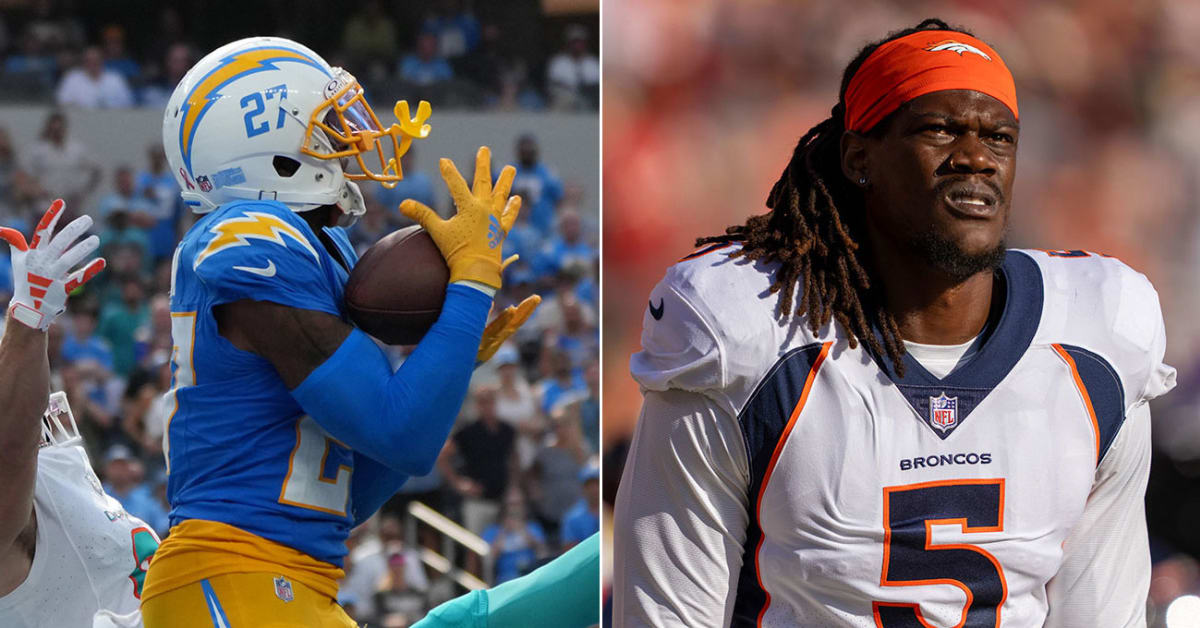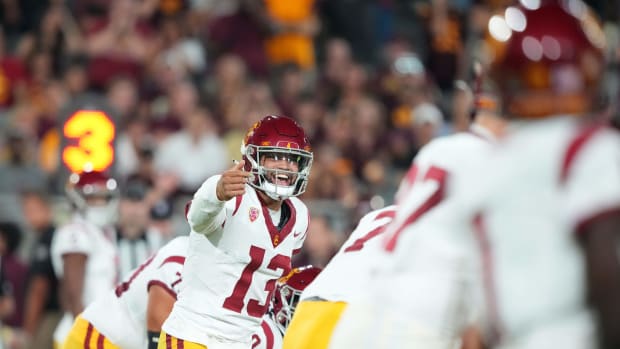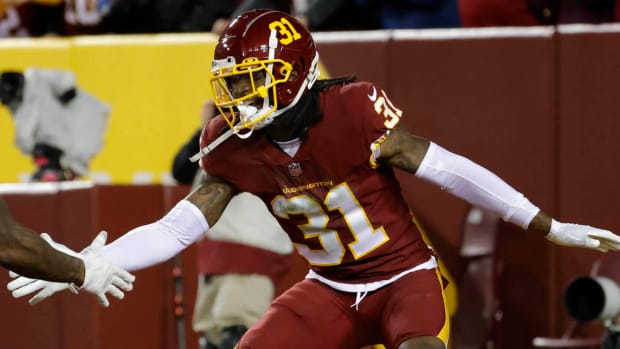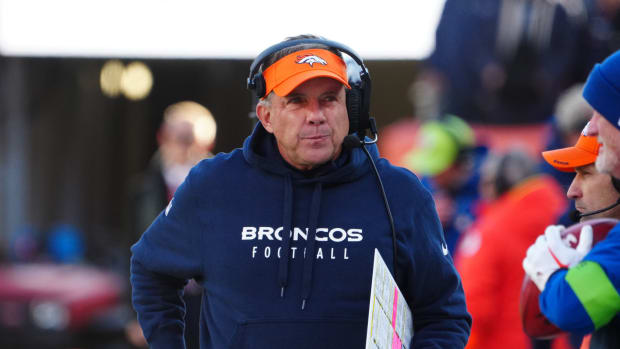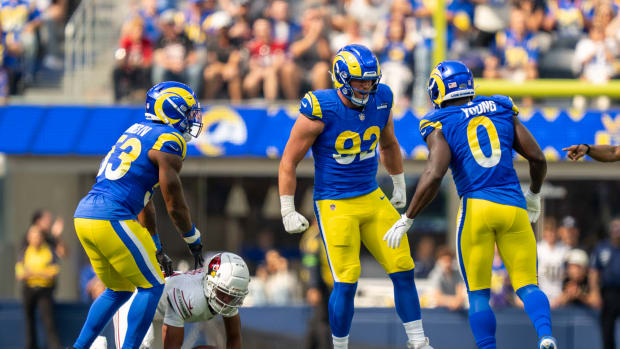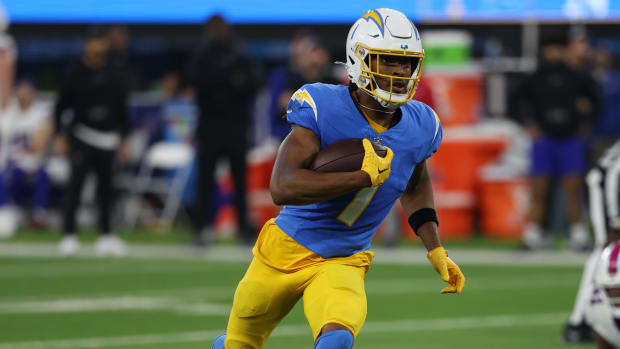Two NFL Teams Have Already Shed Regrettable Free Agent Contracts
Five weeks into the NFL season, the business of football space gives us plenty to examine. Here’s what has caught my eye, a mix of new stories to follow and old ones to revisit.
Buyer beware
Before the start of the 2024 league year next March, excitement will build over free agents set to enter the market and pick a new team. And when they sign—with gaudy numbers reported that come from the agent—there will be buzz from fans and media. It will be all smiles and excitement in March.
And then, at some point, this reality will hit: The vast majority of marquee NFL free-agent contract signings fail, often miserably. The promise of free agency for the team, the player, the fans and the media will not be what it was back on that March day when the signing was announced. It usually ends up, as Billy Joel sings: “The cold remains of a passionate start.”

Jackson and Gregory have both been dealt away by the teams that signed them in 2022.
Kirby Lee/USA TODAY Sports (Jackson); Kyle Terada/USA TODAY Sports (Gregory)
Two players who signed massive free-agent deals in March 2022 illustrate this point as this year’s version of Exhibit A and Exhibit B.
J.C. Jackson, after playing the first four years of his career with the Patriots, signed a (purported) five-year, $82.5 million contract with the Chargers. Less than 20 months into those five years, Jackson was just traded back to the Patriots for nominal compensation (traded along with a 2025 seventh-rounder for a ’25 sixth-rounder).
Randy Gregory, after playing the first five years of his career with the Cowboys, signed a (purported) five-year, $70 million contract with the Broncos. Less than 20 months into those five years, Gregory was traded to the 49ers for the same “ham sandwich” compensation that the Chargers received for Jackson above, though, in the 2024 draft.
To add insult to the injury of these signings, the Chargers and Broncos will be paying the majority of Jackson’s guaranteed $12 million and Gregory’s guaranteed $14 million this season while they play for other teams. The Chargers are counting $11.5 million on their 2023 cap and $19 million on their ’24 cap for Jackson; the Broncos are counting $15.25 million on their ’23 cap and $6.3 million on their ’24 cap for Gregory.
Jackson, at the end of this season, will have made $46 million in his career, $38.5 million (84%) from his 20 months with the Chargers and $7.5 million (16%) from his four-plus years with the Patriots.
Gregory at the end of this season, will have made $35 million in his career, $28 million (82%) coming from his 20 months with the Broncos and the $7 million (18%) from his five-plus seasons with the Cowboys.
Oh, and as for the remaining three years of Jackson’s and Gregory’s contracts, those nonguaranteed years are not worth the paper they are printed on. The Patriots and 49ers will certainly demand less or move on.
These are two cautionary tales of NFL free agency, and there are several like these from every single class, players shed by their teams still in the very early portions of their (purported) five- or six-year contracts.
Yes, there are success stories in free agency. I am proud to have signed Charles Woodson with the Packers (after an excruciating recruitment), but I signed many more free agents who did not work out—even though we did not sign many free agents at all, relative to the rest of the league.
The data is clear: Teams cannot count on this path as a reliable team-building method, especially with the cost involved. I always asked the question about free agents: “Why is his own team not trying harder to sign him? What do they know?” But every year teams—along with their fans and media—get caught up in the chase and the thrill of signing a new free agent, insisting what happened with Jackson and Gregory “will not happen to them.” But it likely will.
Sometimes the best deals you make are the ones you don’t. A more tried-and-true approach is to spend on homegrown players who have been in your program for years. Even if it doesn’t work out, “the devil you know” is better than the one you don’t.
Speaking of which …
Dollars for Daniel

Jones signed a big-money extension right at the franchise tag deadline this summer.
Danielle Parhizkaran/NorthJersey.com / USA TODAY NETWORK
There has been much derision of quarterbacks playing for New York teams this season. The unanticipated ascension of the Jets’ Zach Wilson—after Aaron Rodgers’s season lasted four plays—gave him some benefit of the doubt for a couple of games before the vultures circled due to his poor play. A strong game against the Chiefs and a win against the Broncos has given him reprieve; now the hounds have been on the other New York quarterback, the Giants’ Daniel Jones.
Jones reached the end of his rookie contract in February and was able to wrangle a very player-friendly four-year contract, one that guarantees him $82 million over this year and next. Since that time (and before it), so many have asked me some version of, “Andrew, why did the Giants pay Daniel Jones so much?” Let’s reexamine.
First, an admission that I got to know Jones and his family, in the fall of 2018, and liked them very much. I was assisting Gary Vaynerchuk and VaynerSports in an attempt to sign him as a client; we unfortunately came in second place to CAA (he has since switched to Athletes First). While I am not a scout, I was impressed by Jones’s temperament and humility, and thought he had the mental fortitude to be a successful quarterback.
As with all first-round picks, the Giants had a window with Jones—the offseason after his third year—to exercise a fifth-year option that would have guaranteed him what now seems like a bargain $22.4 million for his fifth season, which would have been this season. The front office—a different one than the current people in place—elected not to, making 2022 the final year of his contract. That timing, along with some unfortunate planning by the Giants, resulted in a financial windfall for Jones.
Unlike their decision on Jones, the Giants did exercise their fifth-year option on Saquon Barkley, drafted a year ahead of Jones, extending the running back’s rookie contract through 2022. In other words, the contracts for the Giants’ two most important players expired at the same time and, for whatever reason, the team was unable to extend either player going into ’23 free agency. Of course, they had the weapon of the franchise tag, but for only one player, and that player ended up being Barkley, which set up Jones for free agency. As we now know, he and Athletes First leveraged that status into a four-year, $160 million contract that will let Jones hit the market again at age 29.
When negotiating contracts and managing the salary cap for the Packers, I learned how important it was to stagger contract expirations for our star players. For example, I would never want Brett Favre’s contract to expire in the same year as another star player, given that having only one tag has downstream effect on retaining or attracting other impactful players. Unfortunately for the Giants, that situation happened, creating the perfect storm for Jones.
Now fans and media have hindsight about the amount the team is paying Jones. But here is the reality: There is no asset more scarce in the NFL than a young quarterback with even limited productivity on the free-agent market. When Kirk Cousins was set free by Washington, he received—at the time—the contract with the most guaranteed money in NFL history. Deshaun Watson received the best contract in NFL history in large part due to the Texans’ letting teams bid for his services in a way that mimicked free agency.
I don’t know which team would have paid Jones, but it would have happened. The position has too much scarcity for a young player coming off a playoff victory in an offense with limited weapons not to break the bank.
As to some saying the Giants should have let Jones go and signed some other stopgap quarterback, what is the point of that? To muddle through with the likes of Andy Dalton, Gardner Minshew, Marcus Mariota, Tyrod Taylor, et al.—the caliber of the usual crop of free-agent quarterbacks—while hoping to draft a quarterback next year and start over? I don’t get that.
In hindsight, obviously it would have been more economical for the Giants to have had Jones on a fifth-year option this year for $22.4 million. Also, in hindsight, it would have been better to tag Jones for $32 million and let Barkley have the leverage of free agency. Running back leverage, as we have seen, is diametrically opposite to quarterback leverage.
Yes, Jones has limitations. Yes, he is overpaid by some measures, so maybe the Giants could have paid “only” $70 million to $75 million over two years instead of $82 million. But the Giants did what they had to do in light of their timing mistake of letting their two star players’ contracts expire at the same time.
It is a cautionary tale not about paying quarterbacks, but about managing and staggering contract negotiations for core players.
Running back surprise

Taylor made his return to action in Week 5 after being activated from the PUP list.
Stephen R. Sylvanie/USA TODAY Sports
A top NFL running back got a new contract! This was a surprising turn of events for the Colts’ Jonathan Taylor, who did have the advantage of youth over running backs who fought a futile fight this summer including Austin Ekeler, Ezekiel Elliott, Dalvin Cook and Saquon Barkley.
Colts management had not only rebuffed his previous attempt to have his contract augmented but also, it seemed, punitively put him on the physically unable to perform (PUP) list for the first four weeks of the season. But alas, perhaps in part due to Taylor’s remaining quiet about the conflict, it has ended well for him.
The reported numbers of $42 million over three years, a $14 million per year average, are skewed, as those are extension year numbers only. In reality, it is a four-year deal worth $46 million, an average of a bit more than $11 million a year. In more stark reality, it is a two-year deal—the guaranteed portion of the contract—for $20.3 million. The Colts will gladly pay him that amount at ages 24 and 25. As for when he reaches age 26 with a nonguaranteed $13 million due? As always, we will see.
































